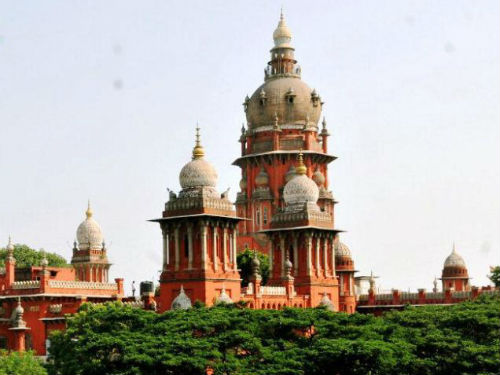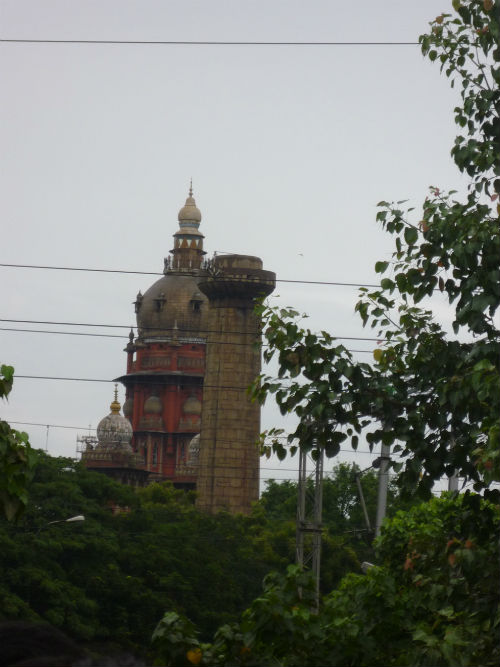Replacing the second in the High Court campus
(Continued fromlast fortnight)

The third lighthouse.

The second and third lighthouses
To follow this story in all its clarity, readers must be wise to this fact. When we say lighthouse, we imagine a tall structure, usually a cylindrical column, with a light on top. This is fine. However, lighthouse experts tell us the part of the structure enclosed in glass and emitting light – using oil+wick/kerosene/electricity – is the lantern room. So, what’s called the “Third Lighthouse” is actually a lantern room on top of the tallest dome on the Madras high court campus.
If this is the third lighthouse, which ones were the first and the second? According to Researcher I.C.R. Prasad, in 1795, commanders of several ships put up a proposal to the Governor in Council in Madras for a lighthouse. “To avoid dangers from Armagoan, Pulicat shoals and Tripasore reef,” they said. A conical wooden tower with a lighting apparatus was placed on top of the two-storeyed Exchange Committee building at Fort St. George. But the lighthouse created more problems than it solved. The cyclone of 1807 damaged the structure so thoroughly, the repair work was as good as constructing a new one. The coconut oil wick used in the lamp leaked and the flame discoloured the surrounding glass. When Argand lamps were introduced for efficient burning of oil, the glass chimneys cracked often. Ship commanders complained of “deficient light” from the reflectors. The cyclone of 1827 dislodged most of the glass-frames. By 1833, the braces supporting the lamps had rusted badly. In effect, the wooden tower was falling apart. A new lantern room was ordered, but the summit of the wooden tower could not accommodate it.
In 1838, a Captain Smith was entrusted with the task of finding a spot for a new lighthouse. Protracted discussions and correspondence between Capt. Smith and the Marine Board followed. On 24 July, 1838, the Governor signed an order that the new lighthouse, a lantern room atop a Doric column, would be built on the Esplanade between the north end of the Fort and Parry’s buildings. That’s where it stands today. The 135-foot tall fluted granite-stone-covered tower was commissioned on January 1, 1844.
Fifty years later, the second lighthouse gave way to a newcomer. The third “lighthouse” (lantern room) on top of a High Court dome opened in 1894.
In his book Madras Exchange Lighthouse, D. Hemachandra Rao traces the story of how a lantern room was put on top of a High Court dome. He is categorical there was no proposal to provide a lantern room on the dome when the court complex was built (it was inaugurated in 1892). But once the tallest dome soared into the sky, it dwarfed the Doric lighthouse column close to it. Ship commanders complained that they needed a light above the existing one as the dome distracted the light at night and was in the line of vision of the lighthouse during daytime.
The governing council agreed and it was decided to install a lantern room, “an engineering marvel”, over the tallest dome in the High Court complex.
The main dome has three stages – a rectangular-shaped first one with stairwells in each corner, an octagonal second stage from which a cast-iron spiral staircase and a flight of straight steps takes you to the third stage. While the first two stages had windows, the third stage had only lancets and Catherine wheels for ventilation. Elders who’ve been to the top (entry was stopped 35 years ago) say that the dome is formed with eight rose-windows and inter-locking granite blocks.
To create the new lighthouse, the top was cut open to provide access to it through a spiral staircase, says Rao. The circular lantern house was 2.5m in diameter, with 2.1m-high murette plates at the bottom. A 1.2m-high glazed portion consisting of 20 triangular-shaped curved glasses would make a 360-degree view possible. The roof was a gilded dome, to match the other domes in the vicinity. The total height of the structure was 190 feet while the light beamed at 166 feet above MSL. “The new tower was altogether 55 feet taller than the existing Doric column,” writes Prasad.
A revolving light emitted by a kerosene lamp was supplied by M/s Chance Brothers, Birmingham, England. It sent out a twin-flash in 30 seconds through a capillary lamp, which was able to produce 18,000 candelas power. The lantern room was commissioned on June 1, 1894.
Amazingly, in spite of being the largest port of east India and the head-quarters of Madras Presidency, the city never got the latest lighting apparatus till India became free. Even the petroleum vapour lamps used world-wide reached the lighthouse only in 1925, and by that time, lighthouses the world-over had switched to electrical lamps. The mystery deepens when you find that a D. Allen Stevenson, a Scottish lighthouse engineer, sent to India in 1927 to report on the condition of Indian lighthouses, had recommended electric lamps to improve lighting on top of the High Court dome. The government did modify several lighthouses through follow-up action on Stevenson’s report, but his suggestion on the Madras lantern-room was by-passed. Mariners had to wait for electric beams till 1977, the year the fourth lighthouse came up on the Marina.
(Concluded)
[…] GEETA PADMANABHAN, The third lighthouse, https://www.madrasmusings.com/vol-27-no-14/the-third-lighthouse; […]